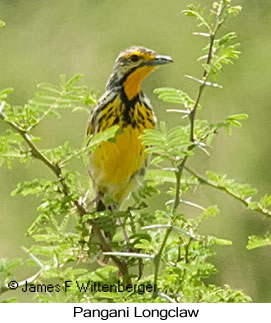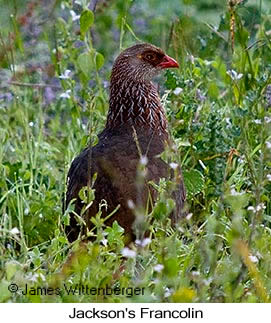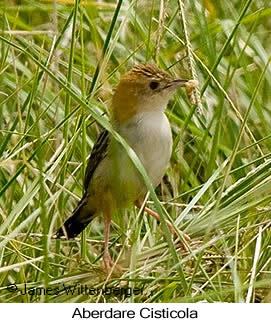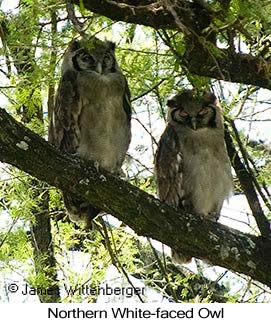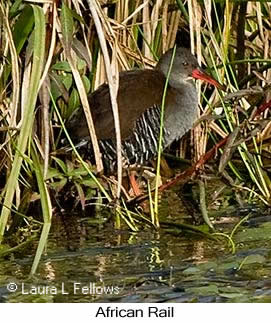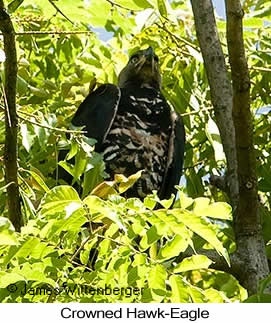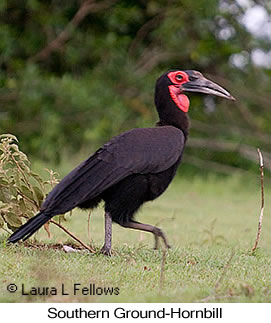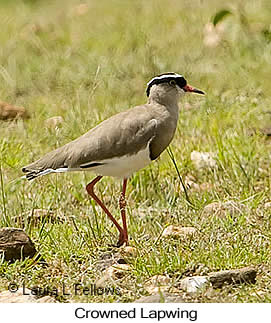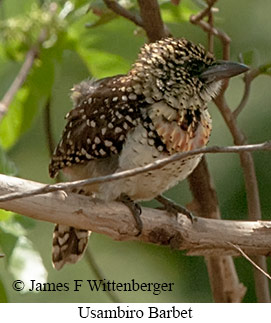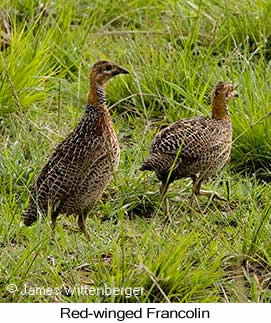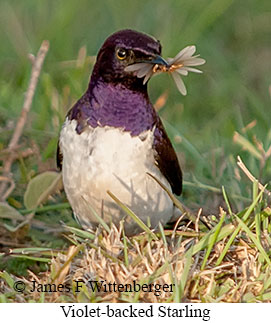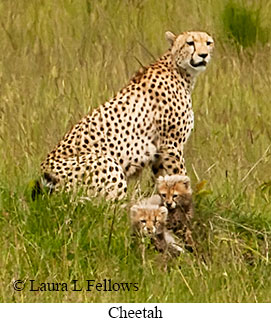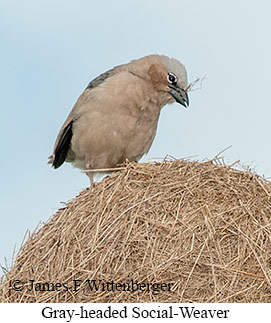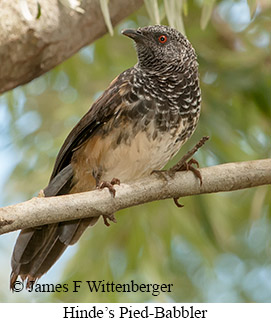KENYA BIRDING TRIP REPORT

TRIP REPORT
KENYA
| Start: | 12/10/2012 |
| End: | 12/29/2012 |
| Duration: | 20 days |
| #Species: | 515 |
| #Endemics: | 17 |
| #Heard Only: | 21 |
2012 Kenya Birding & Mammal Safari
TOUR DESCRIPTION
Our 2012 Kenya tour was organized for a private group of 4 persons, 2 of whom being serious birds and 2 soft birders. Due to the mixed interest level of the group, we arranged for 2 vehicles with 2 drivers/guides, which worked out very well as it allowed some people to continue birding while others returned to the lodge on a number of days. The tour was organized to get a high bird species count while still allowing time to do game drives in several of Kenya's national parks. No one in the group wanted an intensive tour entailing early departures and 12-14 hours of birding every day. The latter is necessary to reach 600 species in the time allotted. We exceeded 500 species of birds in 19 days, the last 2 spent by just us without our group around Mt Kenya. We also saw nearly 40 species of mammals during the tour.
Dec 8-10 were travel days. Our flight out of Dallas-Ft Worth was delayed 3 hours, causing us to miss our connection to Nairobi. British Airways put us all up at a hotel in London for the night and we did not arrive in Nairobi until nearly 10:00 PM on Dec 10. Fortunately, everyone allowed an extra day to reach Nairobi, so we didn't miss any of the scheduled tour. However, we did miss a day of relaxation intended for Dec 10 and were still exhausted from the long flights when the tour began early Dec 11.
Dec 11 was devoted to a game and birding drive through Nairobi National Park. We spent the entire day in the park. A number of species were seen there and nowhere else including Spur-winged Goose, Yellow-necked Francolin, Lappet-faced Vulture, Tawny Eagle, Kori Bustard, Hartlaub's Bustard, Red-chested Cuckoo, Wahlberg's Honeyguide, Fischer's Lovebird, Long-tailed Fiscal, Fischer's Sparrow-Lark, Moustached Grass-Warbler, African Yellow-Warbler, Singing Cisticola, Siffling Cisticola, Zitting Cisticola, Desert Cisticola, Brown Warbler, Southern Black-Flycatcher, Spotted Flycatcher, Rueppell's Robin-Chat, Whinchat, White-breasted White-eye, Pangani Longclaw, Yellow-crowned Bishop, White-winged Widowbird, and African Silverbill. Part of the group saw a black-maned male Lion while the other vehicle saw 2 females with cubs. It was a productive first day and made the park an important ingredient in the overall itinerary. At the same time, it was a tiring day as no one had recovered from the long travel days and jet lag as yet. The less serious birders had seen enough Cisticolas to last a life-time, though we saw many more on ensuing days.
Dec 12 we drove to an unnamed wetland area and then on to Manguo Ponds. Thereafter, we continued on the Gatamaiyu Forest, an important birding site on the eastern escarpment. The best bird at Manguo Ponds was the Western Reef-Heron, seen by some but not all in the group. There was no sign of Maccoa Duck, one of our target species. An intense birding tour would call for departure from Nairobi around 5:30 AM to do these areas justice, but the group decided to leave after breakfast and also spend some time buying souvenirs along the way. Hence, Gatamaiyu Forest didn't get the time needed to take full advantage of possibilities. Notably, we missed the endemic Abbot's Starling, which was seen during the Mt Kenya extension later. Birds we did see included Tambourine Dove, Bar-tailed Trogon, Black-fronted Bushshrike, Black-tailed Oriole, Eastern Mountain-Greenbul, Chestnut-throated Apalis, Northern Double-collared Sunbird, and Long-tailed Widowbird (on the approach road to the forest). During the afternoon transfer to Naivasha, we made some birding stops on the Kiningop Plateau, where we found African Snipe, Eurasian Kestrel, Cape Crow, and the endangered endemic Sharpe's Longclaw. We spent the night at Ellsamere Center, a wonderful place to stay.
Dec 13 was spent birding and doing a game drive around Naivasha National Park. Naivasha is a wonderful birding area, sporting over 300 species and provides enjoyable mammal viewing, Notable birds seen there and not elsewhere were Pink-backed Pelican, Klaas's Cuckoo, Giant Kingfisher, and Tree Pipit. A number of other species seen at Naivasha were only seen in one other place besides there. Elsamere Center provided very comfortable accommodations with good beds that helped everyone catch up on sleep. It was also very nice seeing Joy Adamson's artwork posted on the walls of the dining room, and everyone was encouraged by the environmental education being provided to some of Kenya's brightest young people during our stay.
Dec 14 was a divided day with one vehicle remaining at Naivasha until after lunch while the other did a birding excursion to higher elevation up the access road to Aberdares National Park. The latter group recorded a number of species not picked up elsewhere during the tour, including Jackson's Francolin, Brown Woodland-Warbler, Mountain Yellow-Warbler, and Abyssinian (Schalow's) Wheatear. A number of other species seen in the Aberdare's were only seen at one other locale during the tour. The two vehicles met up at Nakuru National Park in late afternoon, when we did a joint game/birding drive through the park. Due to heavier than normal rains earlier in the year, water levels in the lake were high, causing dilution to the normally alkaline water. As a result, the vast majority of flamingos had moved to north to nearby Lake Bogoria. We nevertheless saw decent numbers of both Greater Flamingo and Lesser Flamingo. We stayed at the expensive but fabulous Lake Nakuru Lodge.
Dec 15 was another divided day. Both groups spent the morning doing a game and birding drive through Lake Nakuru National Park, but one vehicle remained there until after lunch while the other went to the Molo Grassland.mid-morning. Notable birds seen at Lake Nakuru included Cape Teal, Hildebrandt's Francolin, Black Stork, White Stork, Eurasian Hoopoe, White Helmetshrike, and Little Rock-Thrush. Molo Grassland is actually more than a grassland, as there are wetland areas reached with a bit of walking and extensive agricultural activity. Those who went there picked up several species not seen elsewhere. These were Maccoa Duck, missed at Manguo Ponds, Aberdare Cisticola (the main target bird of the area), Wing-snapping Cisticola, a secretive bird that flies up and lands in tall grass quickly so difficult to see well, African Pipit, and Yellow-crowned Canary. We all joined up for the several hour drive to Lake Baringo. That night we stayed at the SOI Safari Lodge, a substitution for Lake Baringo Club which was flooded out due to the high water in the lake. We were lucky to get rooms there, and the rooms the first night were very marginal. We changed to much better rooms for the second night of our stay there.
Dec 16 was spent birding around Lake Baringo. Well over 450 species have been recorded there. We did some early morning birding before breakfast, picking up Crested Francolin, Verreaux's Eagle (distant views of a nesting pair on the cliffs), Dark Chanting-Goshawk, Laughing Dove, Emerald-spotted Wood-Dove, White-bellied Go-away-bird, , Spotted Eagle-Owl, Verreaux's Eagle-Owl, Jackson's Hornbill, Red-fronted Tinkerbird, Lesser Honeyguide, Pygmy Falcon, Pygmy Batis, Slate-colored Boubou, Somali Tit, Mouse-colored Penduline-Tit, Northern Brownbul, Northern Crombec, Red-fronted Warbler, Grayish Flycatcher, Rufous-tailed Scrub-Robin, Mocking Cliff-Chat, Brown-tailed Chat, Brown Babbler, Bristle-crowned Starling, Hunter's Sunbird, Beautiful Sunbird, White-bellied Canary, Little Weaver, Northern Masked-Weaver, and Green-winged Pytilia. Some of the group decided to go back for breakfast, while I went out with the Chege plus a local guide to look for a few more specialties. We found Three-banded Courser, African Scops-Owl, Northern White-faced Owl, Pearl-spotted Owlet, Star-spotted Nightjar, and Slender-tailed Nightjar, none seen elsewhere during the tour. After breakfast we did a boat tour on Lake Baringo, where we saw numerous water birds. Most notable were African Darter and Goliath Heron but everyone was enthralled by the African Fish-Eagles, especially when our boatman threw out a fish that lured the bird in for a very fast catch.
Dec 17 we departed early for Kitale via the Kerio Valley. We made a number of birding stops en route and picked up a number of very good species. Notable were African Rail, White-crested Turaco, White-bellied Go-away-bird, African Swift, Abyssinian Scimitar-bill, Von der Decken's Hornbill, Isabelline Wheatear, Magpie Starling, Mariqua Sunbird, Long-billed Pipit, Yellow-spotted Petronia, White-billed Buffalo-Weaver, White-headed Buffalo-Weaver, Chestnut-crowned Sparrow-Weaver, Fan-tailed Widowbird, and Blue-capped Cordonbleu,. While walking around in a rocky area, I had a bit of a mishap with our brand-new Nikon D800E plus 70-200 mm zoom lens. A rock gave way under foot, banging the camera on the rock and me falling on top of it. It dinged up the lens and put the camera out of commission for the remainder of the trip. Fortunately, we had a backup Nikon D300 with another zoom lens. We stayed at Kitale Golf Club, a hold-over from old colonial days. The rooms could have been more comfortable, but they were adequate for our stay.
Dec 18 we visited nearby Saiwa Swamp National Park, Kenya's smallest. The park is notable for its population of Sitatunga, which we saw, and DeBrazza's Monkey, which we didn't see. Chege told us the latter is seen on only about 40% of visits to the park. The trails are fairly level hard dirt or mud with a number of boardwalks in the swampy areas. Notable birds we saw were Broad-billed Roller, Yellow-billed Barbet, Black-throated Wattle-eye, Luedher's Bushshrike, Purple-throated Cuckoo-shrike, Little Rush-Warbler, and Northern Brown-throated Weaver.
Dec 19 we departed after breakfast for Kakamega, arriving mid-afternoon. We spent the afternoon birding around the grounds of Rondo Retreat (see below for notable species seen during our stay). We spent the next 3 nights at Rondo Retreat, a simply superb place to stay with wonderful food.
Dec 20-21 we birded the Kakamega Forest, nearly the only rainforest remaining in Kenya. Numerous specialty birds not found elsewhere in the country are present there. We spent much of our time birding along the main road, where traffic is fairly regular, but also birding several trails. Notable among the birds seen were Crowned Hawk-Eagle (seen quite well perched in a tree at the entrance to Rondo), Great Blue Turaco (seen every day), African Emerald-Cuckoo, Yellowbill, White-headed Wood-hoopoe, Yellow-billed Barbet, Yellow-spotted Barbet, Least Honeyguide, Speckle-breasted Woodpecker, African Broadbill, Jameson's Wattle-eye (seen by some of the group), Pink-footed Puffback, Brown-crowned Tchagra, Gray-green Bushshrike, Petit's Cuckoo-shrike, MacKinnon's Shrike, Square-tailed Drongo, White-headed Sawwing, Dusky Tit, Slender-billed Greenbul, Shelley's Greenbul, Joyful Greenbul, Little Greenbul, White-browed Crombec, Uganda Wood-Warbler, Buff-throated Apalis, Gray Apalis, White-chinned Prinia, Chubb's Cisticola, Black-faced Rufous-Warbler, Green Hylia, Southern Hyliota, Chapin's Flycatcher (a difficult bird to get and not seen by everyone), Blue-shouldered Robin-Chat (a most secretive and difficult bird to see), Gray-winged Robin-Chat, Snowy-crowned Robin-Chat, Brown-chested Alethe, Equatorial Akalat, White-tailed Ant-Thrush, Stuhlmann's Starling, Green Sunbird, Western Olive Sunbird, Green-throated Sunbird, Oriole Finch, Red-headed Malimbe, Black-necked Weaver, Vieillot's Weaver, Forest Weaver, Gray-headed Negrita, Black-crowned Waxbill, and Red-headed Bluebill.
Dec 22 the group split up, with one vehicle remaining at Kakamega while Laura and I went with Chege to the Busia Grassland near the Uganda border. This is a very poor region, population density is high, and beggars are everywhere. It was a bit unnerving, though Chege assured us the people were harmless. We made a number of roadside stops but skipped a couple areas normally done so we could meet back up with the group in Kisumu before dark. Hence, we missed some species such as Black Bishop normally gotten in this area. We did find Rock Pratincole along the river, Yellow-fronted Tinkerbird, Red-headed Lovebird, Piapiac (raiding garbage along the road), Bar-breasted Firefinch, and a variety of other species that we also saw elsewhere. We stayed at the Sunset Hotel for one night. We don't recommend it, as the rooms are in disrepair and not very comfortable.
Dec 23 we birded an area of roadsides and Papyrus beds near Lake Victoria outside Kisumu around Hippo Point. A number of specialty birds are present in this area. We found Black-billed Barbet, often a tough bird to get, Black-headed Gonolek, Papyrus Gonolek, Angola Swallow, Wire-tailed Swallow, Lesser Striped-Swallow, Greater Swamp Warbler, Lesser Swamp Warbler, Red-faced Cisticola, Black-lored Babbler, Slender-billed Weaver, Black-headed Weaver, Golden-backed Weaver, Red Bishop, Fire-fronted Bishop, Red-Red-headed Bluebill. We also had great views of a Shikra perched on a telephone pole for some time and saw a Palm-nut Vulture, very rare for this area, flying past us. After a late breakfast, we departed for the long drive to Masai Mara. The approach to Ololoolo Escarpment, where we were staying for the next 3 nights, was very muddy due to recent rains. We had to rely on a local Masai man driving a motorbike to navigate off-road up the escarpment to avoid the worst of it. This slowed us down some, and we arrived just before dark. En route we saw a good number of Southern Ground Hornbills along the road near the base of the escarpment in Masai land. We spent the next 3 nights at Mara West tent camp.
Dec 24 we birded the escarpment all day. Some game animals are present, seeking refuge from lions that generally stay out of Masai land outside the park itself. Nevertheless, it's safe enough to bird on foot during daytime. We saw a number of species near the lodge, notably Crowned Hornbill, Spot-flanked Barbet, Rufous-necked Wryneck, Nubian Woodpecker, Black-crowned Tchagra, and Violet-backed Starling. Later that morning and all afternoon we birded a nearby area on the escarpment by vehicle. There we picked up Egyptian Vulture, Crowned Lapwing, Narina Trogon (seen briefly by a few of us), and Usambiro Barbet (a possible future split from D'Arnaud's Barbet) among other species.
Dec 25 was Christmas, and all I wanted for Christmas was a Cheetah or two during our game drive in Masai Mara. The plains are spectacular this time of year, as the grass is green and not yet too tall to see the game animals. Fairly early on, I got my Christmas present. We had spectacular views of a mother Cheetah and 2 young cubs who were frolicking in the grass. We saw lots of other mammals, including 2 male Lions. Notable birds seen this day were Coqui Francolin, Red-winged Francolin (quite rare and a life-bird for our guide), Banded Snake-Eagle, Bataleur, Secretarybird, Namaqua Dove, Southern Ground-Hornbill, Flappet Lark, Red-capped Lark, Rufousa-chested Swallow, Yellow-shouldered Widowbird, Red-collared Widowbird, and African Firefinch.
Dec 26 was last day of the tour for our private group. We spent the morning driving across Masai Mara before transferring back to Nairobi. We drove the southern and eastern sections of the part. Early on our other guide, Peter, spotted a Leopard in the grass some distance off. He only had a brief look and we never saw it again. New birds seen this day or seen better than the previous day included Helmeted Guineafowl, Black-breasted Snake-Eagle, Lesser Spotted-Eagle, Martial Eagle, White-bellied Bustard, Double-banded Courser, Pectoral-patch Cisticola, Rosy-throated Longclaw, and Gray-headed Social-Weaver. We also saw our first Blue Wildebeest, a resident population outside the park on Masai land. We reached Nairobi in early evening and dropped our group off at the airport. Laura and I stayed in Kenya for another 3 days to visit the Mt Kenya area.
Dec 27 we drove to Castle Rock Lodge in the highlands southwest of Mt Kenya National Park. The lodge has some forest on the property. We made several stops en route. At a wetland area we picked up Marsh Warbler. More notably, at a second and rather unplanned stop where Chege had to address a minor problem with the vehicle, we found Cape Robin-Chat and the endemic Hinde's Pied-Babbler. Along the access road to the lodge, we picked up Scaly Francolin. After our arrival, we birded a bit near the lodge and found Delegorgue's (Eastern Bronze-naped) Pigeon. We also saw a flock of Red-fronted Parrots fly overhead. Other species included Scarce Swift and Silvery-cheeked Hornbill.
Dec 28 we birded around the lodge in the morning and picked up both Kenrick's Starling and Abbott's Starling. Chege also saw Abyssinian Crimsonwing, which I missed. After breakfast, we transferred to Serena Mountain Lodge in Mt Kenya National Park. This is a simply superb lodge and quite pricey. Even worse, one must pay the national park entrance fee to reach the lodge, and there is only a couple kilometers of road to bird while getting there. The main attraction at the lodge is the waterhole, which we could view from the balcony of our room. After dark, nocturnal mammals come into the waterhole. The most common aside from Common Warthog and African Buffalo were Bushbucks. Of greater interest was a Common Duiker and a Red Duiker. The lodge also puts out food on a wooden platform, which attracted 4 Genets. On the grounds we also saw Scrub Hare and Egyptian Mongoose on the grounds after dark.
Dec 29 was our last day. We birded the access road leading into the lodge during the morning. The only new bird we saw was Mountain Buzzard. On our way back to Nairobi we stopped in a wetland area where we found a Brown Babbler and many nesting Grosbeak Weavers. That night we began our long flight home, departing Nairobi about 11:30 PM for a 9 hour flight to London, 9 hour layover at Heathrow, and then nearly 10 hour flight back to the US. The travel is painful, but the experiences we had made it all worthwhile.
BIRDING LOCALES
